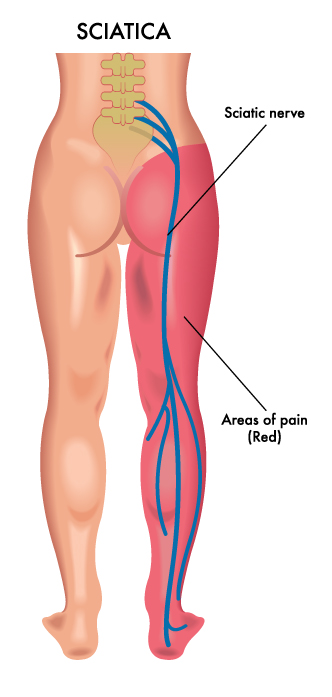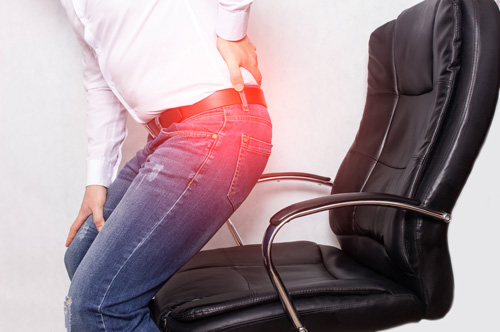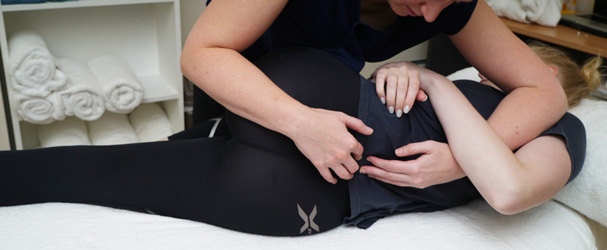Up to 40% of individuals will experience sciatica in their lifetime
Despite how common sciatica is, this type of pain is not well understood by the general population.
Sciatica is not a condition of it’s own
The term “Sciatica” refers to a collection of symptoms in the regions of the body that are supplied by the sciatic nerve.
Sciatica symptoms may include:
- Burning/shooting/sharp pain
- Numbness
- Tingling
- Pins and needles
- Weakness (less common) and,
- Heaviness in the affected leg
The affected sciatic nerve originates in the lower back (lumbar spine L4-S3) and provides motor control to the back of the leg muscles.
Sciatica occurs when the nerve is compressed by other tissues. This may include:
- Lumbar disc bulges or herniations
- Lumbar spinal stenosis (wear and tear to the bones)
- Spondylolisthesis (misalignment of one vertebra on the next)
- Lumbar (low back) or pelvic (buttock region) muscular spasms
- Inflammation surrounding these neural structures

Because sciatica is associated with the above conditions, patients may experience low back or pelvic pain on the same side as the sciatica. Due to the variability in causes, presentation often varies between individuals (e.g. for some the symptoms will stop at the knee, and for others, it will continue down to the foot).
So… Who is affected by sciatica?
Both men and women are equally likely to develop sciatica. However, those over 40 are much more likely to experience these symptoms than other age groups.
Other factors include;
- Sciatica is rare in individuals under 20, except when there has been trauma to the area.
- Occupational predisposition; research shows that machine operators, truck drivers and those are in prolonged awkward or seated postures are at an increased risk of sciatica.
- Some research suggests a potential genetic predisposition
- Other studies indicate that an increased BMI may predispose to sciatica.

Is it sciatica? Be Sure!!
Our professionals are trained to perform physical examinations to determine whether your symptoms are sciatica. And if so, can use further testing to determine what tissues are likely to be compressing your nerves.
Consult with one of our:
- Osteopaths,
- Chiropractors,
- Myotherapists, or
- Remedial Massage Therapists
Get yourself on the road to recovery!
Manual Therapy for Sciatica
Most patients will improve with conservative management, such as manual therapy and pain management strategies. Invasive options (e.g. surgical) are reserved for patients who do not respond to this initial approach.
Recent research has backed the combination of manual therapy and nerve flossing techniques in the reduction of both pain and disability associated with sciatica.
Depending on your presentation, various manual therapy techniques may be used to target any of the joints and muscles surrounding the lumbar spine, hips and pelvis. The aim is to reduce pressure on the nerves, as well as improve blood flow and lymphatic drainage to aid in healing the involved tissues.

Do I need to get imaging (X-rays) done?
Our health professionals will thoroughly discuss your presentation with you (history taking) and perform physical testing to determine a suitable treatment plan. We can then begin to treat your symptoms conservatively. If we have any concerns about your presentation or if your condition isn’t progressing as much as we want, then we may refer you for imaging (e.g. MRI to further assess for other neurological pathologies).
If you’re experiencing sciatica symptoms
Day-to-day tasks can become incredibly challenging!
- Walking
- Tying your shoes
- Getting up and down
- Sleeping
And so much more. Why let pain get in your way?
Let us help you get back to living your best life!
Resources:
-
Harvard Health Online article (https://www.health.harvard.edu/): Sciatica: Of all the nerve. Published February 19, 2016.
-
https://academic.oup.com/aje/article/179/8/929/108237?login=false

Dr Cloe graduated from RMIT with a Bachelor of Health Science and Bachelor of Applied Science (Osteopathy)
